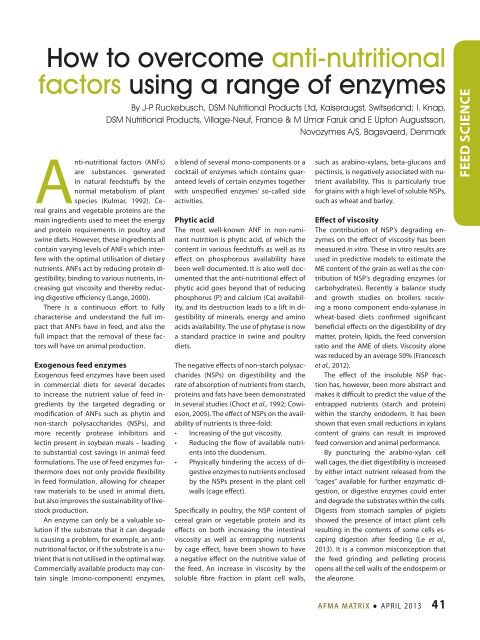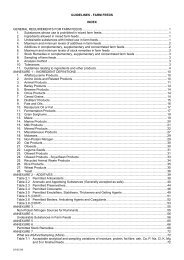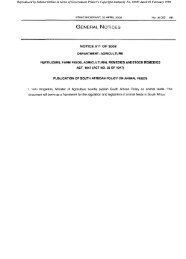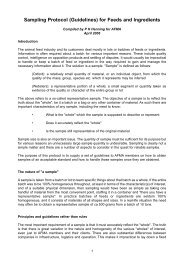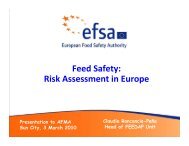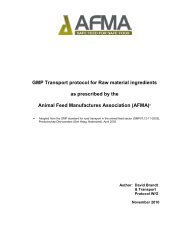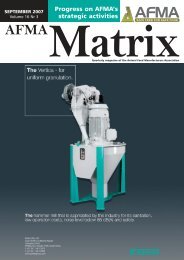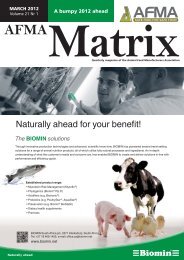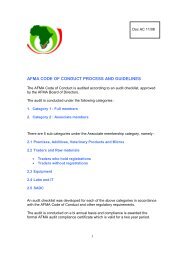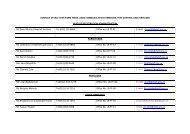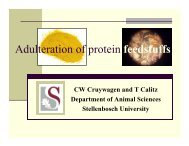Create successful ePaper yourself
Turn your PDF publications into a flip-book with our unique Google optimized e-Paper software.
How to overcome anti-nutritional<br />
factors using a range of enzymes<br />
By J-P Ruckebusch, DSM Nutritional Products Ltd, Kaiseraugst, Switserland; I. Knap,<br />
DSM Nutritional Products, Village-Neuf, France & M Umar Faruk and E Upton Augustsson,<br />
Novozymes A/S, Bagsvaerd, Denmark<br />
Anti-nutritional factors (ANFs)<br />
are substances generated<br />
in natural feedstuffs by the<br />
normal metabolism of plant<br />
species (Kulmar, 1992). Cereal<br />
grains and vegetable proteins are the<br />
main ingredients used to meet the energy<br />
and protein requirements in poultry and<br />
swine diets. However, these ingredients all<br />
contain varying levels of ANFs which interfere<br />
with the optimal utilisation of dietary<br />
nutrients. ANFs act by reducing protein digestibility,<br />
binding to various nutrients, increasing<br />
gut viscosity and thereby reducing<br />
digestive efficiency (Lange, 2000).<br />
There is a continuous effort to fully<br />
characterise and understand the full impact<br />
that ANFs have in feed, and also the<br />
full impact that the removal of these factors<br />
will have on animal production.<br />
Exogenous feed enzymes<br />
Exogenous feed enzymes have been used<br />
in commercial diets for several decades<br />
to increase the nutrient value of feed ingredients<br />
by the targeted degrading or<br />
modification of ANFs such as phytin and<br />
non-starch polysaccharides (NSPs), and<br />
more recently protease inhibitors and<br />
lectin present in soybean meals – leading<br />
to substantial cost savings in animal feed<br />
formulations. The use of feed enzymes furthermore<br />
does not only provide flexibility<br />
in feed formulation, allowing for cheaper<br />
raw materials to be used in animal diets,<br />
but also improves the sustainability of livestock<br />
production.<br />
An enzyme can only be a valuable solution<br />
if the substrate that it can degrade<br />
is causing a problem, for example, an antinutritional<br />
factor, or if the substrate is a nutrient<br />
that is not utilised in the optimal way.<br />
Commercially available products may contain<br />
single (mono-component) enzymes,<br />
a blend of several mono-components or a<br />
cocktail of enzymes which contains guaranteed<br />
levels of certain enzymes together<br />
with unspecified enzymes’ so-called side<br />
activities.<br />
Phytic acid<br />
The most well-known ANF in non-ruminant<br />
nutrition is phytic acid, of which the<br />
content in various feedstuffs as well as its<br />
effect on phosphorous availability have<br />
been well documented. It is also well documented<br />
that the anti-nutritional effect of<br />
phytic acid goes beyond that of reducing<br />
phosphorus (P) and calcium (Ca) availability,<br />
and its destruction leads to a lift in digestibility<br />
of minerals, energy and amino<br />
acids availability. The use of phytase is now<br />
a standard practice in swine and poultry<br />
diets.<br />
The negative effects of non-starch polysaccharides<br />
(NSPs) on digestibility and the<br />
rate of absorption of nutrients from starch,<br />
proteins and fats have been demonstrated<br />
in several studies (Choct et al., 1992; Cowieson,<br />
2005). The effect of NSPs on the availability<br />
of nutrients is three-fold:<br />
• Increasing of the gut viscosity.<br />
• Reducing the flow of available nutrients<br />
into the duodenum.<br />
• Physically hindering the access of digestive<br />
enzymes to nutrients enclosed<br />
by the NSPs present in the plant cell<br />
walls (cage effect).<br />
Specifically in poultry, the NSP content of<br />
cereal grain or vegetable protein and its<br />
effects on both increasing the intestinal<br />
viscosity as well as entrapping nutrients<br />
by cage effect, have been shown to have<br />
a negative effect on the nutritive value of<br />
the feed. An increase in viscosity by the<br />
soluble fibre fraction in plant cell walls,<br />
such as arabino-xylans, beta-glucans and<br />
pectinsis, is negatively associated with nutrient<br />
availability. This is particularly true<br />
for grains with a high level of soluble NSPs,<br />
such as wheat and barley.<br />
Effect of viscosity<br />
The contribution of NSP’s degrading enzymes<br />
on the effect of viscosity has been<br />
measured in vitro. These in vitro results are<br />
used in predictive models to estimate the<br />
ME content of the grain as well as the contribution<br />
of NSP’s degrading enzymes (or<br />
carbohydrates). Recently a balance study<br />
and growth studies on broilers receiving<br />
a mono component endo-xylanase in<br />
wheat-based diets confirmed significant<br />
beneficial effects on the digestibility of dry<br />
matter, protein, lipids, the feed conversion<br />
ratio and the AME of diets. Viscosity alone<br />
was reduced by an average 50% (Francesch<br />
et al., 2012).<br />
The effect of the insoluble NSP fraction<br />
has, however, been more abstract and<br />
makes it difficult to predict the value of the<br />
entrapped nutrients (starch and protein)<br />
within the starchy endoderm. It has been<br />
shown that even small reductions in xylans<br />
content of grains can result in improved<br />
feed conversion and animal performance.<br />
By puncturing the arabino-xylan cell<br />
wall cages, the diet digestibility is increased<br />
by either intact nutrient released from the<br />
“cages” available for further enzymatic digestion,<br />
or digestive enzymes could enter<br />
and degrade the substrates within the cells.<br />
Digests from stomach samples of piglets<br />
showed the presence of intact plant cells<br />
resulting in the contents of some cells escaping<br />
digestion after feeding (Le et al.,<br />
<strong>2013</strong>). It is a common misconception that<br />
the feed grinding and pelleting process<br />
opens all the cell walls of the endosperm or<br />
the aleurone.<br />
Feed science<br />
<strong>AFMA</strong> MATRIX ● APRIL <strong>2013</strong> 41


